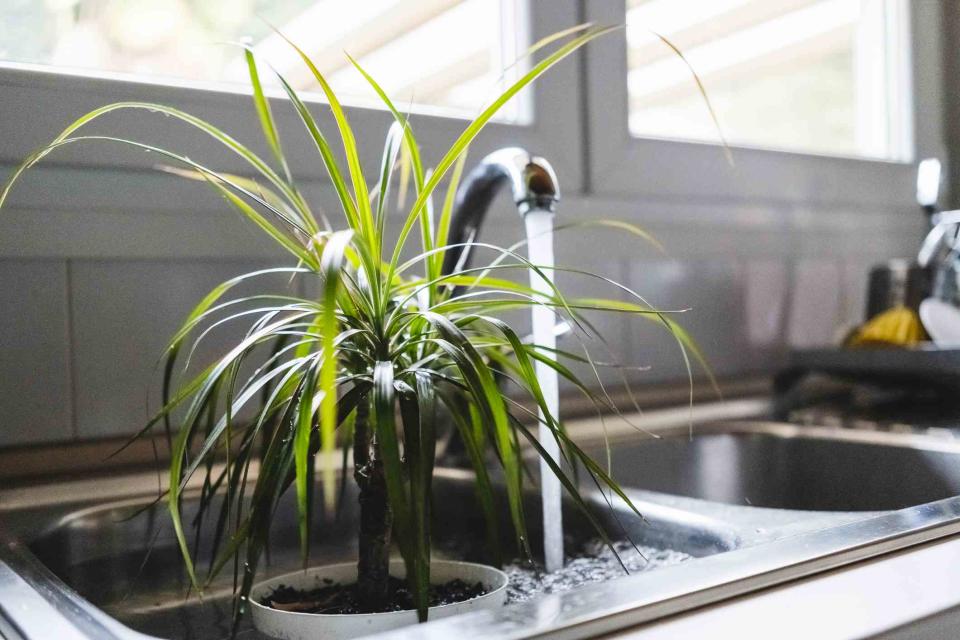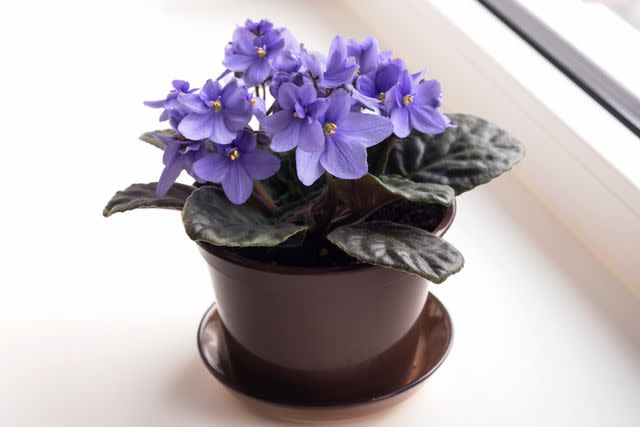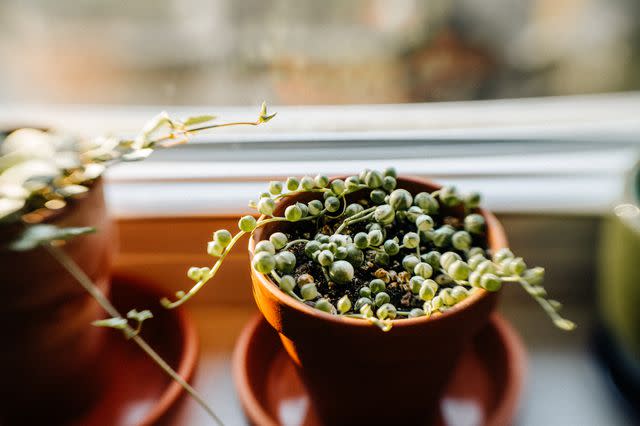The Benefits of Bottom Watering Your Houseplants and How to Do It
Find out which plants like it and get tips to water like a pro

massimo colombo / Getty Images
Reviewed by Julie Thompson-Adolf
When watering potted plants, overwatering can be just as detrimental as underwatering. Besides watering frequency, the watering method you use also plays a role in how much water the plant gets. Potted plants can be watered either from the top or from the bottom. Although watering from the top is the most common method, it is not always the best.
This article gives you the gist on bottom watering and helps you decide whether it’s right for your plants.
What Is Bottom Watering for Plants?
Bottom watering, also called reverse watering, is adding water to the saucer underneath the pot, or placing the pot in a bucket, sink, or another large container of water. The water is slowly absorbed and drawn into the potting medium through the drainage holes of the pot.
Benefits of Bottom Watering
If it’s done properly, bottom watering has several benefits. First, water is better absorbed with this method, especially when the potting medium is dry. This eliminates water running through the potting medium like in top watering, or worse, running off the soil surface and spilling out of the pot, which can happen when the soil is very dry.
Second, bottom watering ensures all of the potting medium gets saturated, not just the top layer. This lets plants develop stronger, deeper root systems as the roots are growing toward the water source.
Third, it is a more controlled watering method than top watering, because you don’t give the plant more than the potting medium can absorb. It also avoids getting the plant leaves wet, which some plants don’t like.
And fourth, bottom watering discourages fungus gnats from laying their eggs. Fungus gnat females lay up to 200 eggs on the surface of moist potting medium.

Ludmila Kapustkina / Getty Images
African violets should be bottom wateredTypes of Plants You Can Bottom Water
Provided that they are grown in pots with good-size drainage holes and a potting medium that absorbs moisture well, almost any plants can be bottom-watered. Keep in mind, though, that bottom watering takes longer than top watering, so if time is an issue, choose top watering. Also, very large containers should be top watered if they're too heavy to move to a tub, because they'll be even heavier once they're watered.
These plants are prime candidates for bottom watering:
Plants with hairy or fuzzy leaves, such as African violets, or plants that don’t like getting their leaves wet, such as snake plants, Philodendron verrucosum, and P. micans. When wet, the leaves of these plants tend to rot easily.
Plants grown in soilless mixes.
Plants with a dense leaf cover that makes it difficult for water to reach the soil surface.
Plants whose leaves or crown can get damaged when it gets wet, such as cyclamen and begonias.
Plants whose potting medium has dried out severely. Only very slow watering from the bottom ensures that the entire soil medium gets moistened thoroughly.
Tip
Even if the plants are suitable for bottom watering, they should be top watered once every four to six months, because soluble salts from the fertilizer build up in the potting medium. Top watering until water runs out of the bottom through the drainage holes is the only way to flush out those salts. Make sure to discard that water and never let your houseplants sit in it.

Cavan Images / Getty Images
How to Bottom Water Plants
Fill a sink or tub with room-temperature water (add fertilizer if needed). If your municipal water contains chlorine, consider using filtered or distilled water. Make sure the water level covers the bottom inch of the pot.
Let the pot soak up the water until the top layer of the potting medium feels moist (insert your index finger in the soil to check). For small pots, it takes about 15 minutes.
Remove the pot from the sink or tub and allow it to drain, then place it back on its saucer.
Frequently Asked Questions
Is watering plants from the bottom better?
It depends on the plant; some plants are better watered from the bottom. It is generally viewed as the better method because it is less likely to overwater your plants that way, but the drawback is that it takes longer than top watering.
Can you overwater a plant by bottom watering?
Yes, if you water the plant too often, or if you let the plant sit in a saucer filled with water, your plant will end up overwatered. A few minutes longer than needed is unlikely to harm the plant but you shouldn't let it sit in water for hours or overnight.
How long should I bottom water my plants?
The time it takes for the potting medium to get soaked can vary greatly. The rule of thumb is at least 15 minutes. The larger the pot, and the drier the soil, the longer it takes to reach that stage.
How often should I bottom water my plants?
It depends on the type of plant and its watering needs. Instead of following a watering schedule, check the moisture level of the soil and water the plants as needed. Houseplants that need consistently moist soil need watering every few days whereas succulent and other drought-resistance plants are fine with weekly watering or even less.
Read Next: The 7 Best Watering Cans of 2024, Tested and Reviewed
Read the original article on The Spruce.

